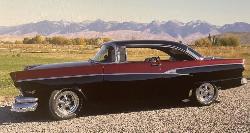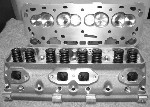|
Author
|
Message
|
|
46yblock
|
|
|
Group: Forum Members
Last Active: 12 Years Ago
Posts: 1.2K,
Visits: 7.8K
|
speedpro56 (12/12/2009)
The only time I ever found crud in a steam hole would be when the block was drilled and the head was not and the coolent couldn't pass thru. When the holes were in the block and head I have not yet found crud buildup that bad and this may well be the engines always had antifreeze changed yearly ?????I suspect the abscence of changing antifreeze on this '64 is the reason for the plug. The block is like new except for a mess within the coolant passages. It looks like the antifreeze was never changed after rebuild, except for when the radiator was replaced. Even then the owner probably only drained the radiator. Rebuild was done in 1994, and engine had 11,000 miles over the next 10 years. Then it sat idle for 4 or 5 years.
Mike, located in the Siskiyou mountains, Southern, OR 292 powered 1946 Ford 1/2 ton, '62 Mercury Meteor, '55 Country Squire (parting out), '64 Falcon, '54 Ford 600 tractor.

|
|
|
|
|
aussiebill
|
|
|
Group: Forum Members
Last Active: 5 Years Ago
Posts: 1.8K,
Visits: 11.4K
|
Rono (12/12/2009)
I am building a C2AE block with 471 heads. I believe both the heads and block have the factory steam holes. I have never used the Best head gaskets (only Fel-Pro) and wondered if they have the steam holes? Rono. Rono, yes the Best gaskets do have the steam holes in them. Must say i,ve allways drilled my engines and never had any problems with the steam holes. best regards bill.
 AussieBill YYYY Forever Y Block YYYY AussieBill YYYY Forever Y Block YYYY Down Under, Australia
|
|
|
|
|
speedpro56
|
|
|
Group: Forum Members
Last Active: Last Year
Posts: 1.3K,
Visits: 9.2K
|
The only time I ever found crud in a steam hole would be when the block was drilled and the head was not and the coolent couldn't pass thru. When the holes were in the block and head I have not yet found crud buildup that bad and this may well be the engines always had antifreeze changed yearly ?????
-Gary Burnette-
|
|
|
|
|
DANIEL TINDER
|
|
|
Group: Forum Members
Last Active: 2 days ago
Posts: 1.7K,
Visits: 154.2K
|
Best gaskets DO have the holes.
6 VOLTS/POS. GRD. NW INDIANA
|
|
|
|
|
Rono
|
|
|
Group: Forum Members
Last Active: Last Year
Posts: 1.3K,
Visits: 80.0K
|
I am building a C2AE block with 471 heads. I believe both the heads and block have the factory steam holes. I have never used the Best head gaskets (only Fel-Pro) and wondered if they have the steam holes? Rono.
 Ron Lane, Meridian, ID Ron Lane, Meridian, ID
|
|
|
|
|
Doug T
|
|
|
Group: Forum Members
Last Active: 4 Months Ago
Posts: 563,
Visits: 2.6K
|
Interesting Thread. I have always drilled the "steam holes" although as was said above that is probably a misnomer. As long as the water temp in the area does not exceed the boiling point of the coolant mix at the rad cap pressure, there will not be steam there or anywhere else. But I remember reading about some Smokey Unick research on Y's when he ran them in '57. He found significant temp differences in various locations of the water jackets and there could be local boiling which would not show up in the temp gauge. It may be that Ford found this also with research and specified the holes as a fix. Because Ford would be using clean blocks and coolant the holes would not be crudded up. My guess is that the boiling and overheating takes place primarly when the engine is shut down hot and water circulation is only thermo syphon. Then the holes would pass water to the area between the ex valves where the heat would build up quickly, cooling that area. BTW Ted mentions another interesting Y design feature that has a little bit of unintended concequences. Since the the temp probe is located in the back of the head near where a large part of the water flow from the rad comes up from the block, the water exiting the head is likely to be some what hotter. I don't know if it helped or not but I have a magazine picture of Doane Spenser's T bird motor that has beautiful water manifolds the take water from the back and front of the heads.
Doug T The Highlands, Louisville, Ky. 
|
|
|
|
|
46yblock
|
|
|
Group: Forum Members
Last Active: 12 Years Ago
Posts: 1.2K,
Visits: 7.8K
|
Good point on the plugging John. The relativey " new block" I ordered the steele gaskets from you for, has at least one of the smaller holes plugged, in the 64 pickup. Will punch out the plug and flush the system after all its back together.
Mike, located in the Siskiyou mountains, Southern, OR 292 powered 1946 Ford 1/2 ton, '62 Mercury Meteor, '55 Country Squire (parting out), '64 Falcon, '54 Ford 600 tractor.

|
|
|
|
|
John Mummert
|
|
|
Group: Forum Members
Last Active: Last Week
Posts: 916,
Visits: 7.5K
|
WOW! I'm almost afraid to weigh-in here. From my observation the steam holes were added in 1961. C0AE and C0TE heads don't have them and C1AE heads do. I can't recall ever seeing a C1TE that didn't but a suppose it is possible. Steam hole is probably a misnomer. Additional cooling hole would be more accurate. The adjacent exhaust valves/ports put additional heat in this area. The holes are meant to supply additional cooling water from the block to this area. Regarding the size, in most of the heads I pull off that have them the holes are plugged with crude, so they probably didn't do much. In theory they are probably a good idea but in practice they might not have helped much. I don't think the -113 heads are any more prone to cracking than ECZ-G or -471 heads. I find all these about 30% cracked. ECZ-C heads crack between the center exhaust springs, under the valve cover but this is not as common. ECL heads crack between the intake and exhaust seats. I think that stuck heat risers in the exhaust caused as many cracked heads as anything. The 57 later heads always crack in the exhaust seat connecting to the crossover passage first. If they're not cracked there, they probably aren't cracked anywhere. I have never seen a crack extending from one of the steam holes either in a block or a head. BUT, I have no testing to prove that they helped or hurt head gaskets or cooling.
http://ford-y-block.com 20 miles east of San Diego, 20 miles north of Mexico 
|
|
|
|
|
PF Arcand
|
|
|
Group: Forum Members
Last Active: Last Year
Posts: 3.3K,
Visits: 238.8K
|
It's been mentioned here before that 113 heads are more prone to cracking between the exhaust valves than other Y heads. So, even though the extra holes won't pass a lot of coolant, wouldn't they be of some benefit in the case of these heads?
Paul
|
|
|
|
|
Ted
|
|
|
Group: Administrators
Last Active: 2 days ago
Posts: 7.5K,
Visits: 205.8K
|
Dave. Thanks for the reinforcement on the sizing of the ‘steam holes’ not contributing heavily to actual cooling. That mirrors my sentiments. I’ve actually had to downsize the intermediate cooling holes in the decks on the small block Fords in which to decrease overall heating temperatures or prevent overheating in certain instances.
For all. What must be remembered is that the coolant for the Y circulates into the block and to the rear of the engine at which point it then enters the head and comes forward again to enter the intake manifold and then back to the radiator. Any coolant holes placed in the block deck and heads prior to the rear of the engine circumvents the coolant reaching the rear of the block and in turn permits the rear of the engine and heads to run warmer. It’s a fine balance to equalize the temperatures throughout the block and heads without abnormally large variances in coolant temperatures being present throughout. yehaabill (3/6/2008)
Y-Guys Don't hold this against me, but the 400 small block scrub has the "steam" holes and a lot of them seem to have problems... My 2cnts Bill Bill. In rereading this post from its beginning, I noticed you did not get an answer to what was a pertinent question. The simple answer is that the 400 scrub utilizes siamese cylinder walls which essentially prevents air from from being relieved between the lower sides of the cylinders and hence the need for ‘steam’ holes. These holes allow pockets of air to be vented out and instead allows coolant to fill those voids. But as you mention, there are many documented problems with these particular blocks in regards to cracks fanning out from the steam holes in the decks. But in this case, the steam holes and the resultant cracks are obviously a deterent to the larger problem of hot pockets that would exist otherwise.
  Lorena, Texas (South of Waco) Lorena, Texas (South of Waco)
|
|
|
|